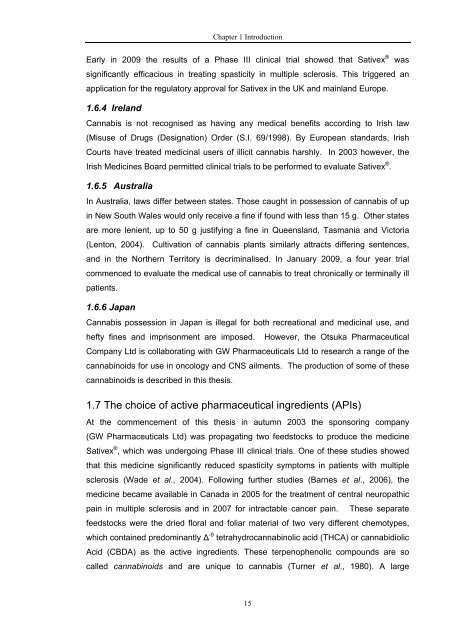finalfullthesisdjpotter
finalfullthesisdjpotter
finalfullthesisdjpotter
Create successful ePaper yourself
Turn your PDF publications into a flip-book with our unique Google optimized e-Paper software.
Chapter 1 Introduction<br />
Early in 2009 the results of a Phase III clinical trial showed that Sativex ® was<br />
significantly efficacious in treating spasticity in multiple sclerosis. This triggered an<br />
application for the regulatory approval for Sativex in the UK and mainland Europe.<br />
1.6.4 Ireland<br />
Cannabis is not recognised as having any medical benefits according to Irish law<br />
(Misuse of Drugs (Designation) Order (S.I. 69/1998). By European standards, Irish<br />
Courts have treated medicinal users of illicit cannabis harshly. In 2003 however, the<br />
Irish Medicines Board permitted clinical trials to be performed to evaluate Sativex ® .<br />
1.6.5 Australia<br />
In Australia, laws differ between states. Those caught in possession of cannabis of up<br />
in New South Wales would only receive a fine if found with less than 15 g. Other states<br />
are more lenient, up to 50 g justifying a fine in Queensland, Tasmania and Victoria<br />
(Lenton, 2004). Cultivation of cannabis plants similarly attracts differing sentences,<br />
and in the Northern Territory is decriminalised. In January 2009, a four year trial<br />
commenced to evaluate the medical use of cannabis to treat chronically or terminally ill<br />
patients.<br />
1.6.6 Japan<br />
Cannabis possession in Japan is illegal for both recreational and medicinal use, and<br />
hefty fines and imprisonment are imposed. However, the Otsuka Pharmaceutical<br />
Company Ltd is collaborating with GW Pharmaceuticals Ltd to research a range of the<br />
cannabinoids for use in oncology and CNS ailments. The production of some of these<br />
cannabinoids is described in this thesis.<br />
1.7 The choice of active pharmaceutical ingredients (APIs)<br />
At the commencement of this thesis in autumn 2003 the sponsoring company<br />
(GW Pharmaceuticals Ltd) was propagating two feedstocks to produce the medicine<br />
Sativex ® , which was undergoing Phase III clinical trials. One of these studies showed<br />
that this medicine significantly reduced spasticity symptoms in patients with multiple<br />
sclerosis (Wade et al., 2004). Following further studies (Barnes et al., 2006), the<br />
medicine became available in Canada in 2005 for the treatment of central neuropathic<br />
pain in multiple sclerosis and in 2007 for intractable cancer pain. These separate<br />
feedstocks were the dried floral and foliar material of two very different chemotypes,<br />
which contained predominantly Δ -9 tetrahydrocannabinolic acid (THCA) or cannabidiolic<br />
Acid (CBDA) as the active ingredients. These terpenophenolic compounds are so<br />
called cannabinoids and are unique to cannabis (Turner et al., 1980). A large<br />
15


